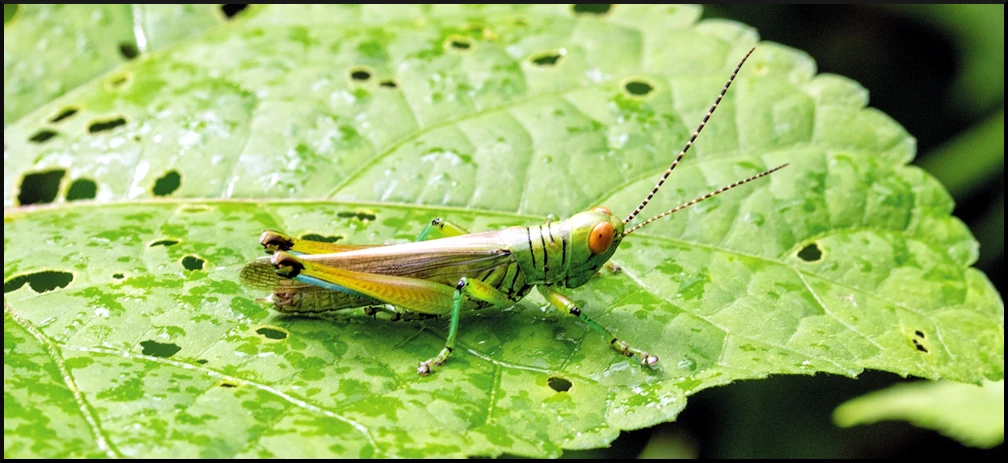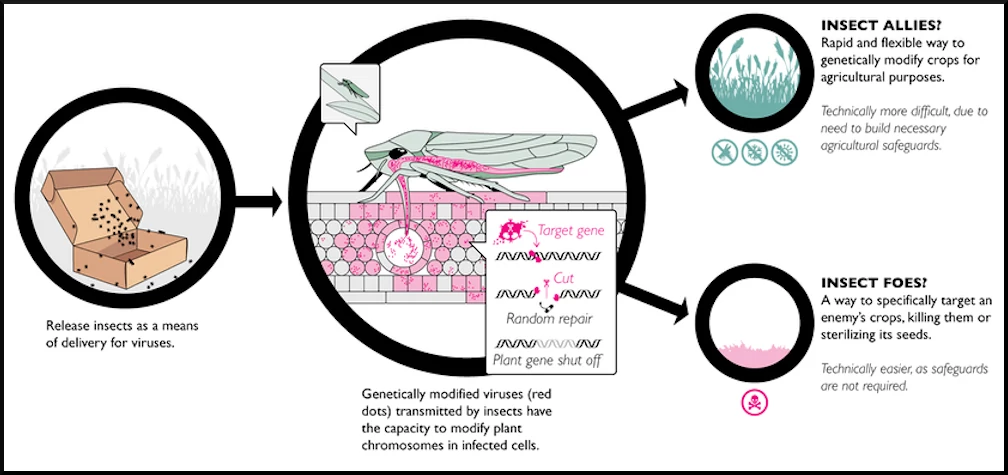by Shan Jie and Fan Wei, published in Global Times, May 24, 2022
The conflict between Russia and Ukraine has led to a global food crisis, at a time of climate change, pollution, and other threats to the food supply. In the predictable future, food problems will be a permanent fixture in the world, while conflicts arising from “wars on crops” will also become an international issue of great concern.
Since 2016, the advanced military research institute in the US proposed a defense program, known as the “Insect Allies,” which it said was to confront potential food supply risks. However, the Pentagon uses insects to deliver a “genetically engineered virus” that could affect crop growth by altering which genes the plants express, media reported.
After being announced, the plan has received wide criticism from scientists and experts around the world, warning that the Insect Allies might open an easily weaponized technological “Pandora’s box.”
The intentions of the Pentagon are also in question – is it really to save humanity from starvation, or will it, on the contrary, deliberately cause a humanitarian crisis in order to serve some “military aims.”
Experts reached by the Global Times said the Insect Allies is turning this concern into a real potential danger. “Why do they use insects as carriers? Why does the US build bio-labs near other countries like Russia? When the Pandora’s Box is opened, a series of disasters will follow,” said an expert.
However, this is just a tip of the iceberg as a project with a potential biological weapons threat. In addition to the Insect Allies program, the US has conducted biological experiments around the world in said notorious “bio-labs” disregarding human safety and natural ethics while blatantly violating the “Biological Weapons Convention.”

Insects become ‘bioweapons‘
The Defense Advanced Research Projects Agency (DARPA) is a research and development agency in the United States Department of Defense responsible for developing high-tech military applications.
Ever since DARPA announced the Insect Allies in the name of preventing disaster and increasing productivity, controversies surrounding the proposal have never stopped swirling.
According to the DARPA website, the program is pursuing “scalable, readily deployable, and generalizable countermeasures” against “potential natural and engineered threats” to food supply with the goals of preserving the US crop system.
It states that the program, “by applying targeted therapies,” seeks to mitigate the impact of incursions, including naturally occurring threats to the crop system and “threats introduced by state or non-state actors,” which can quickly jeopardize national security.
The Insect Allies program aims to transfer modified genes to plants through insect vectors along with the plant viruses they transmit, which involves three technical areas – viral manipulation, insect vector optimization, and selective gene therapy in mature plants, according to DARPA.
To achieve this goal, the $45 million project has founded at least four research institutes, the media reported previously.
It is reported that one of Insect Allies’ experiments in 2017 involved maize and tomato plants and dispersal insect species including leafhoppers, whiteflies, and aphids.
However, DARPA’s concept and the intention behind it have hardly convinced scientists. As early as in April 2018, an article on Science warned that the crop-protecting insects from Insect Allies “could be turned into bioweapons.”
“If successful, the technique could be used by malicious actors to help spread diseases to almost any crop species and devastate harvests, they say. The research may be a breach of the Biological Weapons Convention,”
read the Science article, quoting European scientists.
“The program may be widely perceived as an effort to develop biological agents for hostile purposes and their means of delivery,” the critics noted.
Germany’s Max Planck Institute also indicated that the Insect Allies “could easily be misused for developing biological weapons.”
In a critical review published in January 2022 on Society of Environmental Toxicology and Chemistry, scientists noted that
“the combination of a virus-induced genetic modification of crop plants in the field using genetically modified insect vectors poses a greater risk than the hitherto existing use of genetically modified organisms.”
In 2019, Forbes listed Insect Allies on the list of “Tech Ethics Issues We Should All Be Thinking About.” “Is this a biological weapon? Will it motivate other countries to develop the technology in defense? ” Forbes asked.
Zhang Jie, an expert from the Institute of Plant Protection under the Chinese Academy of Agricultural Sciences (CAAS), told the Global Times that the possibility of using insects as vectors for harmful bacteria and viruses to attack crops and cause a food crisis not only exists, but also has a lot of room for expansion.
He said that three main crops – rice, wheat and corn – all have deadly viruses, bacteria, or fungi. In reality, targeted pests, such as rice planthoppers and wheat aphids, can carry different viruses to infect the crops, causing huge losses.
“It would be deadly to transform an insect into a bioweapon, because until now, viruses in crops have been very difficult to control. Once an infected crop develops symptoms, it is almost impossible to save. And the virus keeps variating, creating even more difficulties in prevention,” Zhang said.
Zhou Huanbin, Zhang’s colleague who studies genome editing, told the Global Times that in the gene editing of crops, some principles must be followed, one of which is to minimize the risk of uncontrolled spread of gene-edited crops.
Also concerning the controllability of the project, Gregory Kaebnick, an ethicist at the Hastings Center bioethics research institute in New York, was quoted by AP as saying that once they are introduced into the fields, insects and microbes “might be impossible to remove.” He warned that the Insect Allies technology could “end up being destructive.”
Biological Weapons Convention violations
The Insect Allies plan has been labeled as a “biological weapon” by Western scholars since the day it was announced, triggering a big discussion in Western academic circles and the media about whether the plan violates the United Nations’ Biological Weapons Convention (BWC).
“Because of the broad ban of the Biological Weapons Convention, any biological research of concern must be plausibly justified as serving peaceful purposes. The Insect Allies program could be seen to violate the Biological Weapons Convention, if the motivations presented by DARPA are not plausible,” the Max Planck Institute article noted.
As the cornerstone of international biological arms control, the BWC was ready for signing in 1972 and went into effect in 1975, with more than 180 state parties.
However, the US first pushed for the striking down of the BWC, but later became the only country to oppose the establishment of a multilateral verification mechanism for the convention.
“To use insects as a vector to spread diseases is a classical bioweapon,” Silja Voeneky, a professor of international law at the University of Freiburg in Germany, told The Washington Post.
According to Voeneky, in this program, using insects as a key feature is “particularly alarming, because insects could be deployed cheaply and surreptitiously by malevolent actors.”
Her worry is echoed by Chinese military expert Song Zhongping, who also called the Insect Allies technology a “typical form of biological weapons.”
“It could reduce crop yields in targeted countries and artificially create food crises there. Then it loses its independence in the food sector and might become dependent on US food exports, including genetically modified food, which is part of biological warfare,” Song said.
Song believes that the US really needs to explain why insects are to be used as vectors in this research, especially as insects could quietly disseminate viruses into crops in other countries.
“It is not difficult to understand why the US will set up biological laboratories around rival nations, because only in these places can the labs ensure the localization of the species they use in experiments,” he said. “For instance, it would be problematic if they bring American insects to a lab in Ukraine and release them in Russia.”
Long history of insect vector use
The Insect Allies program is just one of many instances in which the US’ research was accused of causing dire consequences around the world especially through the use of biological laboratories.
The US openly admitted that it runs 336 biological laboratories in 30 countries around the world, including 26 in Ukraine. However, the contracts suggest that the US has signed contracts with 49 countries, way more than it had admitted to.
The Pentagon has a long history of using insects as disease vectors. According to a partially declassified 1981 US Army report, US biological warfare scientists conducted multiple experiments on insects.
In the 1980s, the United States Army Medical Research Institute of Infectious Diseases came up with experiments to see “if sand flies and mosquitoes could be vectors of Rift Valley Virus, Dengue, Chikungunya, and Eastern Equine Encephalitis.” The US Army researched their potential as bio-weapons, according to Bulgarian investigative journalist Dilyana Gaytandzhieva.
Under a US Army operation codenamed May Day in the same decade, Aedes Aegupti mosquitoes were dispersed through ground based methods in Georgia state of the US. The mosquitoes are alleged to be the vectors of dengue, chikungunya and the Zika virus.
Gaytandzhieva also revealed that the Pentagon has allegedly performed entomological warfare tests in countries such as Georgia and Russia.
In 2014, the US-built Lugar Center near Tbilisi, capital of Georgia was equipped with an insect facility and launched a project called “Raising Awareness about Barcoding of Sand Flies in Georgia and Caucasus.” Two other programs were also undertaken at the center in the following years.
As a result, Tbilisi has been infested with biting flies since 2015, which have developed non-typical behavior from what they have previously exhibited, such as the newly emerged flies surviving indoors year-round, and being also highly resistant to cold.
The biting flies were also found in nearby Dagestan region of Russia.
Moreover, while conducting research into deadly viruses and bacteria, the US was unable to ensure the security of its biological laboratories. The Pentagon admitted in 2015 that since 2003, live samples of anthrax were mistakenly sent from the Dugway Proving Ground military base near Salt Lake City, Utah, to all 50 states as well as nine countries, including the UK, South Korea, and Germany.
*Featured Image: ~ ScienceForums.com

The USA not just out of control, without any controls. the MIC rules the USA.